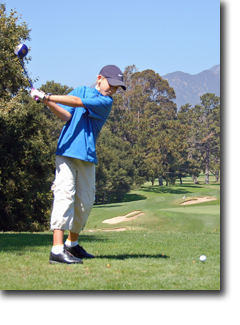

GENERAL Choose the club off the tee that works best off the tee. If you currently are unable to hit the driver with confidence it may be wise to use a 3 wood or even a 5 wood off the tee. Often the shorter clubs such as the 3 or 5 woods allow the novice to average player a little more control off the tee. The 3 and 5 woods have a more lofted clubface. This additional loft puts more backspin on the shots, which reduces the amount of sidespin on tee shots. Many players feel they should always try to hit the driver in order to not lose distance. Initially, it is far more important to make consistent solid contact and have some reasonable idea of where the tee shot will go. If you choose to hit driver, make sure to have a driver that is right for your golf game. Many people are trying to hit drivers that are not properly fitted for them. They are either hitting old small woods that should be upgraded or, they are hitting clubs that have too little loft and are either too heavy and/or too stiff for their physical abilities. Make sure that you choose a club with at least 10.5 degrees of loft and a medium/regular shaft. This should help to get a little more backspin from the driver which will lead to keeping the ball in play. If you don’t wish to buy the newest and the best from this years model, you can often find second hand drivers from golf shops that have merchandise trade in policies. Sometimes golf catalog retailer will have some great clearance merchandise sales to make room for the incoming models. There are some great deals out there without having to spend $350 or more. Driver techniques to help the beginner to average players Learn to swing the club in rhythm and not try to overpower every tee shot. The driver is the lightest club in the bag. People know it should be hit the farthest so they too often try to overhit the shot, which is absolutely unnecessary. You get the most distance from a driver through faster club head speed and center hitting the face of the club. Overswinging often leads to falling off balance and missing the sweet spot of the club which ultimately loses all the benefits of trying to swing faster. Position the ball forward towards the front foot of your stance. This position promotes sweeping the ball off the tee. Positioning the ball too far back in your stance it can make the downswing too narrow, causing actually hitting down on a driver. When positioning the ball properly towards the front foot, you have effectively moved the ball beyond the bottom of the swing arc which encourages a shallower angle of attack. As a general rule for the driver it’s better to swing up through the ball than to hit down on the shot. Widen your stance. The insides of your feet should basically be the width of your shoulders. This wider base will help stabilize the swing for the driver which happens to be the biggest and longest swing in the game. This will also encourage a wider, shallower bottom to your driver swing. Unlike the irons or fairway woods which are hit with a descending blow, you want to learn to widen and shallow your downswing to get the most consistent speed, launch and spin of your drives. Learn to keep your head and neck behind the shot. I’m cautious when I teach this technique. I am not saying to stay back on the shot all the way to the finish. Into impact the head should remain relatively quiet and not lead forward towards the target coming into the shot. Directly after impact and as direct result of the energy transfer of the shot, your upper body including your head should come forward and end up over your left leg. I do not want to encourage players to keep too much pressure on their necks and back by staying back on the shots too long. This creates what is commonly known as reverse c position of the back which makes the lower body slide forward towards the target as the upper body hangs back too far behind. This action can put a tremendous amount of pressure on the back and is obviously not my intension. Coil around your flexed right knee – Keep weight on the inside of right foot. The greatest swingers of the club seemed to have done these skills very well. By learning how to coil around your right knee and keep your weight on the inside of your foot, you become more stable. This allows you to load energy in the backswing to be delivered in the downswing. Relax your shoulders, forearms and wrists. 70% of your distance from your golf shots should be directly related to the energy transfer from the hands and wrists in the shot. When you try to hit really hard, you will often tighten up. Tension in a golf swing is ultimately resistance and interference which slows the club head down. I use an analogy of trying to drive your car with your foot on the brake and accelerator at the same time. You can feel the car’s acceleration trying to move the car faster. The brakes, however, are holding the car back from its top acceleration. Too much tension in your hands, wrists, forearms and shoulders will ultimately act as the brakes in that analogy and inhibit the full acceleration of the club head through the swing. Learn to swing fast not hard. That is a very difficult lesson for the average player and it is why the tour professionals look like they seemingly swing so effortless. It’s like a duck on a pond. On the surface they look calm, but under water their webbed feet are paddling fast. |
  |
